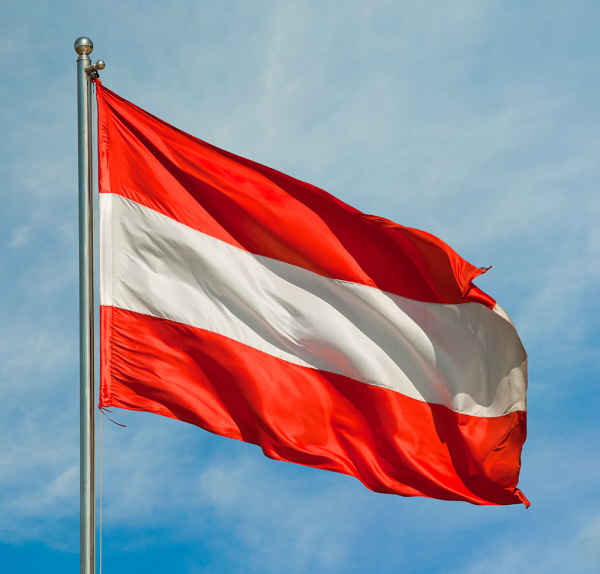
Austria, a land steeped in rich history and culture, offers the avid traveler a treasure trove of most beautiful historical sites for tourists. From ancient castles to grand palaces, this article explores the top 10 must-visit historical landmarks that glimpse Austria’s fascinating past and architectural splendor.
Top 10 historical sites.
1. Schönbrunn Palace (Schloss Schönbrunn)
2. Hofburg Palace
3. Melk Abbey (Stift Melk)
4. Salzburg Cathedral (Salzburger Dom)
5. Hohensalzburg Fortress (Festung Hohensalzburg)
6. Schloss Eggenberg
7. Wachau Valley
8. Kunsthistorisches Museum
9. Mauthausen Memorial
10. Hallstatt
1. Schönbrunn Palace (Schloss Schönbrunn) Austria.
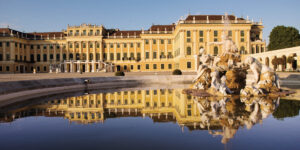
Schönbrunn Palace, or Schloss Schönbrunn in German, stands as a jewel of Baroque architecture and imperial grandeur in Vienna, Austria.
This UNESCO World Heritage site is one of the historical sites, on the outskirts of Vienna, Austria, attracting tourists with its beauty and showcasing the Habsburg dynasty’s luxury and power.
Over time, it gradually evolved into a lavish summer residence for the Habsburg emperors; consequently, each contributed to its expansion and embellishment.
The palace is surrounded by expansive gardens and parklands that are meticulously landscaped in the French Baroque style. Moreover, these gardens enhance the palace’s grandeur and historical significance.
Visitors can stroll along tree-lined avenues; additionally, they can visit the gloriette perched on a hilltop, offering panoramic views of Vienna. Alternatively, they can admire the Neptune Fountain and the Roman Ruins.
Schönbrunn Palace is not just a historic monument but a cultural icon that offers a glimpse into Austria’s imperial past and the lavish lifestyle of its rulers.
A visit here is a journey through centuries of art, architecture, and aristocratic life. Consequently, it is a must-see destination for tourists in Vienna.
This magnificent Baroque palace in Vienna served as the summer residence of the Habsburg monarchs; moreover, it boasts stunning gardens, an impressive Gloriette, and the world’s oldest zoo.
2. Hofburg Palace Austria.
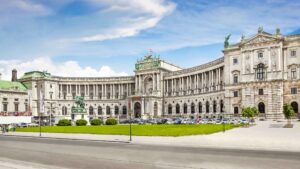
The Hofburg Palace is one of the most beautiful historical sites in the heart of Vienna, Austria, which is a sprawling royal complex that encapsulates centuries of Habsburg rule and Austrian history and attracts tourists.
This magnificent palace, originally constructed in the 13th century, served as the principal residence and administrative center of the Habsburg dynasty, one of Europe’s most influential royal families.
The palace complex is a fusion of architectural styles, reflecting its long history of expansion and renovation.
Visitors are greeted by the imposing Swiss Wing, which houses the iconic Spanish Riding School where Lipizzaner horses perform their elegant maneuvers.
Nearby, the Imperial Chancellery Wing and the Amalienburg Wing showcase elegant Baroque and Neoclassical facades.
Inside Hofburg Palace, visitors can explore a myriad of attractions that offer insights into imperial life.
The Imperial Apartments, lavishly decorated with period furnishings and artworks, provide a glimpse into the private lives of emperors and empresses.
The Sisi Museum pays homage to Empress Elisabeth (Sisi), showcasing personal items and artifacts from her life.
The palace also houses the impressive Imperial Treasury (Schatzkammer), displaying the Habsburgs’ priceless collection of crown jewels, religious relics, and ceremonial regalia.
Beyond its historical significance, Hofburg Palace remains a vibrant cultural hub. It hosts the Austrian National Library, one of the world’s oldest and largest, housing countless manuscripts, rare books, and historical documents.
The palace also includes the Burgkapelle (Court Chapel), where the Vienna Boys’ Choir performs during Mass.
Surrounded by beautiful gardens and adjacent to Vienna’s historic center, Hofburg Palace stands as a testament to Austria’s imperial legacy and continues to enchant visitors with its grandeur, history, and cultural treasures.
3. Melk Abbey (Stift Melk) Austria.
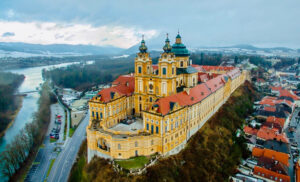
Melk Abbey, known as Stift Melk in German, is a magnificent Benedictine abbey perched atop a rocky outcrop overlooking the Danube River in Lower Austria.
This iconic landmark, dating back to the 11th century, is renowned for its stunning Baroque architecture, rich cultural heritage, and breathtaking views of the Wachau Valley.
The abbey’s imposing yellow façade, adorned with intricate statues and frescoes, commands attention as visitors approach.
The abbey’s imposing yellow façade, adorned with intricate statues and frescoes, commands attention as visitors approach; moreover, its grandeur sets the tone for the beauty that lies within.
The grand entrance leads into a world of ornate halls, opulent libraries, and majestic courtyards that reflect the abbey’s role as a center of spiritual and intellectual life in Austria.
Melk Abbey’s Marble Hall (Marmorsaal) is a Baroque masterpiece with gilded stucco, frescoes by Paul Troger, and Danube views.
The library, a treasure trove of medieval manuscripts and rare books, showcases the abbey’s scholarly legacy and houses over 100,000 volumes.
In short the abbey church, with its twin towers and elegant dome, is a masterpiece of Austrian Baroque architecture, housing a stunning high altar and a wealth of religious art.
Tourists can visit the Melk Abbey Museum Austria, one of the most historical sites, with exhibits on the abbey’s history, art, and the daily life of its monks over the centuries.
The abbey’s gardens, meticulously landscaped with geometric patterns and vibrant flowers, provide a tranquil setting for contemplation and relaxation.
Melk Abbey continues to be an active Benedictine monastery, where monks live, work, and pray in accordance with centuries-old traditions.
Its enduring beauty and cultural significance make it a must-visit destination for tourists exploring the enchanting Wachau Valley and the rich history of Austria.
4. Salzburg Cathedral (Salzburger Dom) Austria.
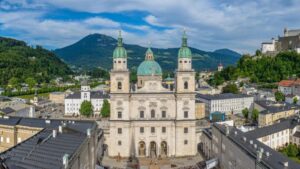
The Salzburg Cathedral, known locally as Salzburger Dom, stands as a prominent symbol of faith and Baroque splendor in the heart of Salzburg, Austria.
Located in the charming Old Town (Altstadt), this majestic cathedral is dedicated to Saint Rupert and Saint Virgil, two important figures in the city’s Christian history.
The current cathedral, dating back to the 17th century, impresses visitors with its imposing facade adorned with marble statues of saints; additionally, it features intricate Baroque ornamentation.
The twin towers, topped with distinctive green domes, dominate the skyline of Salzburg and serve as a beacon for those exploring the city.
Upon entering the Salzburg Cathedral, a sanctuary of grandeur and spiritual richness greets visitors.
Lavish stucco work, gold leaf, and vibrant frescoes depicting scenes from the Bible and the lives of saints decorate the interior; furthermore, these elements enhance the opulence and spiritual ambiance of the space.
The main altar, crafted from white marble, is a masterpiece adorned with sculptures and surrounded by ornate chapels dedicated to various saints.
One of the most notable features of the cathedral is the magnificent organ, which dates back to the 18th century and still resonates with beautiful melodies during Mass and concerts.
Adjacent to the cathedral is the Residenzplatz, a spacious square where visitors can admire the cathedral’s architecture and the stunning Baroque fountain, known as the Residenzbrunnen, which adds to the area’s charm.
Salzburg Cathedral Austria serves not only as a place of worship but also as one of the cultural and historical sites that embody the city’s rich heritage and artistic achievements that also attract tourists to visit the area.
Its serene atmosphere and architectural beauty make it a must-visit destination for tourists exploring the cultural treasures of Salzburg.
5. Hohensalzburg Fortress (Festung Hohensalzburg) Austria.
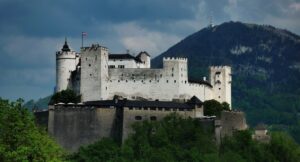
Tourists can explore one of the most beautiful historical sites, Hohensalzburg Fortress (Festung Hohensalzburg), the largest, and best-preserved medieval fortress in Europe is located atop the Festungsberg hill overlooking the city of Salzburg, Austria.
This imposing structure, dating back to the 11th century, has consequently become an iconic symbol of Salzburg’s history, military prowess, and architectural splendor.
Approaching the fortress, visitors are greeted by its formidable walls and towers, which have withstood centuries of sieges and wars.
The main entrance, guarded by the massive Reisszug gate, leads into a labyrinthine complex of courtyards, bastions, and medieval chambers.
The main entrance, guarded by the massive Reisszug gate, consequently leads into a labyrinthine complex of courtyards, bastions, and medieval chambers.
The interior of Hohensalzburg Fortress offers a journey through time with its richly furnished rooms. For example, the Golden Hall (Goldene Saal) is adorned with intricate Gothic woodwork and provides stunning views of the city below.
The fortress museums provide insights into its military history, showcasing armor, weaponry, and artifacts from various periods.
One of the highlights of a visit is the ascent to the fortress via the funicular railway; moreover, it offers panoramic views of Salzburg and the surrounding Alpine landscape.
From the top, visitors can explore the fortress ramparts, which offer unparalleled vistas of the city, the Salzach River, and the distant Bavarian Alps.
Throughout the year, Hohensalzburg Fortress hosts cultural events, concerts, and theatrical performances that showcase its acoustically renowned venues, such as the Burgsaal and the Knights’ Hall (Rittersaal).
Hohensalzburg Fortress is not just a historic monument but a living testament to Salzburg’s medieval past and a must-visit destination for tourists seeking panoramic views, cultural experiences, and a glimpse into Austria’s rich heritage.
6. Schloss Eggenberg Austria.
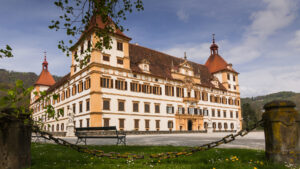
Schloss Eggenberg, located in Graz, Austria, is a stunning Baroque palace and UNESCO World Heritage site that epitomizes the wealth and cultural sophistication of its era.
Built in the early 17th century by the influential Eggenberg family, the palace is renowned for its harmonious blend of architecture, art, and symbolism.
Approaching Schloss Eggenberg, visitors immediately notice its grandeur and the picturesque setting amidst landscaped gardens and sprawling parklands; furthermore, creating a captivating first impression of the historical estate.
The palace’s distinctive yellow facade, adorned with elaborate stucco decorations and frescoes depicting mythological scenes, reflects the Baroque ideals of magnificence and opulence.
Inside the palace, visitors can explore lavishly furnished rooms that provide a glimpse into the lifestyle of Graz’s aristocracy; furthermore, offering a fascinating insight into the opulence and grandeur of the past.
The Planetary Room (Planetenzimmer), adorned with ceiling frescoes representing the seven planets known in the Baroque era, symbolizes the Eggenberg family’s interest in astrology and cosmology.
The Alte Galerie houses an impressive collection of European art, including paintings, sculptures, and decorative arts from the Middle Ages to the 18th century, offering insights into the cultural tastes and patronage of the Eggenbergs; furthermore, providing a glimpse into the artistic legacy of the region.
The palace grounds feature expansive gardens with ornamental fountains, manicured lawns, and pathways that invite leisurely strolls.
The landscaped terraces provide panoramic views of Graz and the surrounding countryside; consequently, they create a picturesque setting for relaxation and contemplation.
Schloss Eggenberg continues to captivate visitors with its architectural beauty, historical significance, and cultural treasures; therefore, it is a must-visit destination for tourists exploring the rich heritage of Graz and the Baroque splendor of Austria.
7. Wachau Valley Austria.
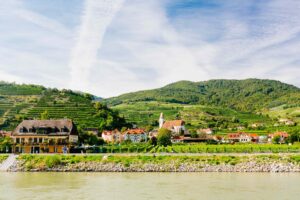
Tourists can explore the Wachau Valley one of the most beautiful historical sites, a UNESCO World Heritage site nestled along the Danube River between Melk and Krems in Lower Austria, is a picturesque region renowned for its stunning landscapes, historic towns, and world-class wines.
Spanning approximately 30 kilometers, this enchanting valley offers a blend of natural beauty, cultural heritage, and culinary delights that captivate visitors year-round.
Terraced vineyards cling to steep hillsides, quaint villages have charming cobblestone streets, and medieval castles perch atop rocky outcrops in the Wachau Valley.
The region’s fertile soils and favorable climate create ideal conditions for wine cultivation, particularly Grüner Veltliner and Riesling, which thrive in the vineyards lining the valley slopes.
Visitors to the Wachau Valley can embark on leisurely boat cruises along the Danube, offering panoramic views of the vineyards, orchards, and historic villages dotting the riverbanks.
Cycling enthusiasts can explore the well-marked Danube Cycle Path, winding through picturesque landscapes and offering opportunities to visit local wineries and sample regional delicacies; in addition, to providing a delightful blend of outdoor adventure and culinary experiences.
Historic towns such as Dürnstein, with its iconic blue-towered abbey and medieval charm, and Krems, a cultural hub with museums and art galleries, invite visitors to stroll through narrow alleys and discover centuries-old architecture.
The Wachau Valley is also known for its culinary delights, including apricots (Marillen) used in traditional pastries, artisanal cheeses, and locally sourced delicacies served in charming Heuriger taverns.
Whether admiring the valley’s natural beauty, exploring its rich history, or savoring its renowned wines and cuisine, a visit to the Wachau Valley promises an unforgettable experience that embodies the essence of Austrian culture and hospitality.
8. Kunsthistorisches Museum Austria.
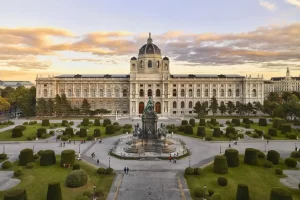
The Kunsthistorisches Museum, located in Vienna, Austria, stands as a beacon of art and culture, housing one of the world’s foremost collections of fine art and antiquities.
Built in the late 19th century under Emperor Franz Joseph I, this magnificent museum is not only celebrated for its extensive and diverse artworks but also for its stunning architectural grandeur.
Approaching the Kunsthistorisches Museum, visitors are greeted by a monumental Neo-Renaissance façade adorned with columns, sculptures, and intricate detailing that reflect the opulence and cultural ambition of the Habsburg Empire.
The museum’s location on the Ringstraße, Vienna’s prestigious boulevard, further enhances its historical and architectural significance.
Inside, the Kunsthistorisches Museum boasts a rich array of masterpieces from across centuries and continents.
The Picture Gallery (Gemäldegalerie) showcases works by renowned artists such as Vermeer, Rembrandt, Raphael, and Velázquez, offering a comprehensive survey of European painting from the Middle Ages to the Baroque period.
Visitors can also explore themed exhibitions, temporary displays, and educational programs that delve into various aspects of art history and cultural heritage.
The Kunsthistorisches Museum not only serves as a cultural institution but also as a testament to Vienna’s legacy as a center of artistic patronage and intellectual discourse.
A visit here promises an enriching experience immersed in the world of art, history, and craftsmanship that defines Austria’s cultural identity.
9. Mauthausen Memorial Austria.
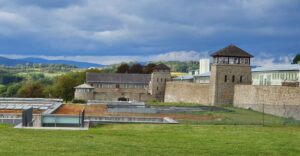
The Mauthausen Memorial, located near the town of Mauthausen in Upper Austria, serves as a solemn testament to the horrors of the Holocaust and Nazi concentration camps during World War II.
The memorial at the former Mauthausen-Gusen concentration camp complex commemorates the suffering and loss of thousands of prisoners.
The Mauthausen Memorial confronts visitors with stark reminders of the camp’s dark history, highlighting the importance of remembrance and education.
The main entrance, flanked by haunting stone walls inscribed with the words “Arbeit macht frei” (Work sets you free), leads into a sobering landscape of barracks, watchtowers, and quarry pits where prisoners toiled under inhumane conditions; thus, providing a chilling glimpse into the atrocities of the past.
The memorial’s exhibition center offers a comprehensive overview of the camp’s history, documenting the experiences of prisoners from across Europe, including political dissidents, Jews, Roma, and prisoners of war.
Personal testimonies, photographs, and artifacts provide poignant insights into the daily lives and struggles of those incarcerated in Mauthausen-Gusen; additionally, they serve as powerful reminders of the human cost of war and oppression.
The “Room of Names” serves as a memorial to the victims, displaying the names and countries of origin of thousands who perished within the camp’s walls.
The memorial grounds also include poignant sculptures, memorials, and a symbolic cemetery where visitors can pay their respects to the victims.
Guided tours and educational programs are available to deepen understanding and foster reflection on the atrocities committed during the Holocaust and the importance of remembrance and tolerance.
Visiting the Mauthausen Memorial is a powerful and solemn experience, offering an opportunity to honor the memory of those who suffered and perished while reaffirming a commitment to human rights and justice for future generations.
10. Hallstatt Austria.
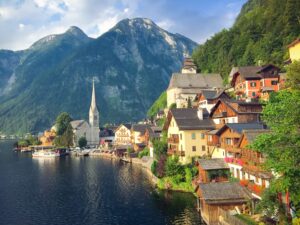
Hallstatt, Austria, nestled amidst the spectacular Salzkammergut region and overlooking the serene Hallstätter See (Lake Hallstatt), is a picture-perfect village that captivates visitors with its natural beauty, rich history, and charming architecture.
Tourists can explore this recognized as one of the most beautiful historical sites of UNESCO World Heritage site, Hallstatt Austria is renowned for its idyllic setting, nestled between the Dachstein Alps and the shimmering lake, creating a scene straight out of a fairy tale.
The village of Hallstatt itself is a postcard-worthy destination, characterized by narrow cobblestone streets, colorful pastel-painted houses adorned with window boxes brimming with flowers, and centuries-old churches and chapels.
The Hallstatt Skywalk, accessed by a funicular railway, offers breathtaking panoramic views of the village, lake, and surrounding mountains; furthermore, providing an unforgettable vista that encapsulates the region’s natural splendor.
Hallstatt’s history dates back thousands of years; moreover, with evidence of prehistoric salt mining in the nearby Salzberg (Salt Mountain) and archaeological finds housed in the Hallstatt Museum.
Visitors can delve into the village’s salt mining heritage; consequently, which has shaped its economy and cultural identity over the centuries.
The Hallstätter See invites exploration; additionally, with boat cruises offering tranquil views of the lakeshore and surrounding mountains.
Hiking trails meander through pristine alpine meadows and dense forests, providing opportunities to immerse oneself in the region’s natural beauty.
Local cuisine in Hallstatt emphasizes fresh fish from the lake, hearty Austrian dishes, and delightful pastries enjoyed in cozy lakeside cafes and restaurants.
Whether exploring its historical landmarks, enjoying outdoor activities, or simply soaking in the serene ambiance, Hallstatt promises a memorable experience that highlights Austria’s alpine charm and cultural richness.







